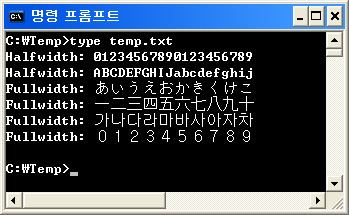Plane BMP | Assigned 225 code points | |
 | ||
Range U+FF00..U+FFEF(240 code points) Scripts Hangul (52 char.)Katakana (55 char.)Latin (52 char.)Common (66 char.) Symbol sets Variant width characters Unused 15 reserved code points | ||
In CJK (Chinese, Japanese and Korean) computing, graphic characters are traditionally classed into fullwidth (in Taiwan and Hong Kong: 全形; in CJK and Japanese: 全角) and halfwidth (in Taiwan and Hong Kong: 半形; in CJK and Japanese: 半角) characters. With fixed-width fonts, a halfwidth character occupies half the width of a fullwidth character, hence the name.
Contents
In the days of computer terminals and text mode computing, characters were normally laid out in a grid, often 80 columns by 24 or 25 lines. Each character was displayed as a small dot matrix, often about 8 pixels wide, and an SBCS (single byte character set) was generally used to encode characters of western languages.
For a number of practical and aesthetic reasons, Han characters would need to be twice as wide as these fixed-width SBCS characters. These "fullwidth characters" were typically encoded in a DBCS (double byte character set), although less common systems used other variable-width character sets that used more bytes per character.
Halfwidth and Fullwidth Forms is also the name of a Unicode block U+FF00–FFEF.
In Unicode
In Unicode, if a certain grapheme can be represented as either a fullwidth character or a halfwidth character, it is said to have both a fullwidth form and a halfwidth form.
Halfwidth and Fullwidth Forms is the name of Unicode block U+FF00–FFEF, the last of the Basic Multilingual Plane excepting the short Specials block at U+FFF0–FFFF.
Range U+FF01–FF5E reproduces the characters of ASCII 21 to 7E as fullwidth forms, that is, a fixed width form used in CJK computing. This is useful for typesetting Latin characters in a CJK environment. U+FF00 does not correspond to a fullwidth ASCII 20 (space character), since that role is already fulfilled by U+3000 "ideographic space."
Range U+FF65–FFDC encodes halfwidth forms of Katakana and Hangul characters – see half-width kana. Range U+FFE0–FFEE includes fullwidth and halfwidth symbols.
In OpenType
OpenType has the fwid and hwid "feature tag" to be used for providing fullwidth or halfwidth form of a character.
